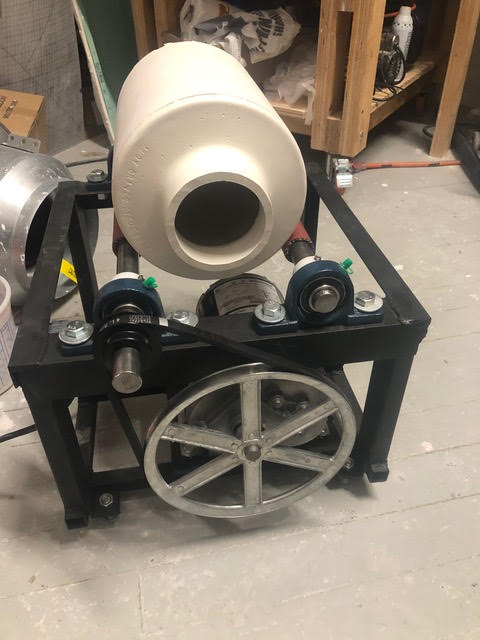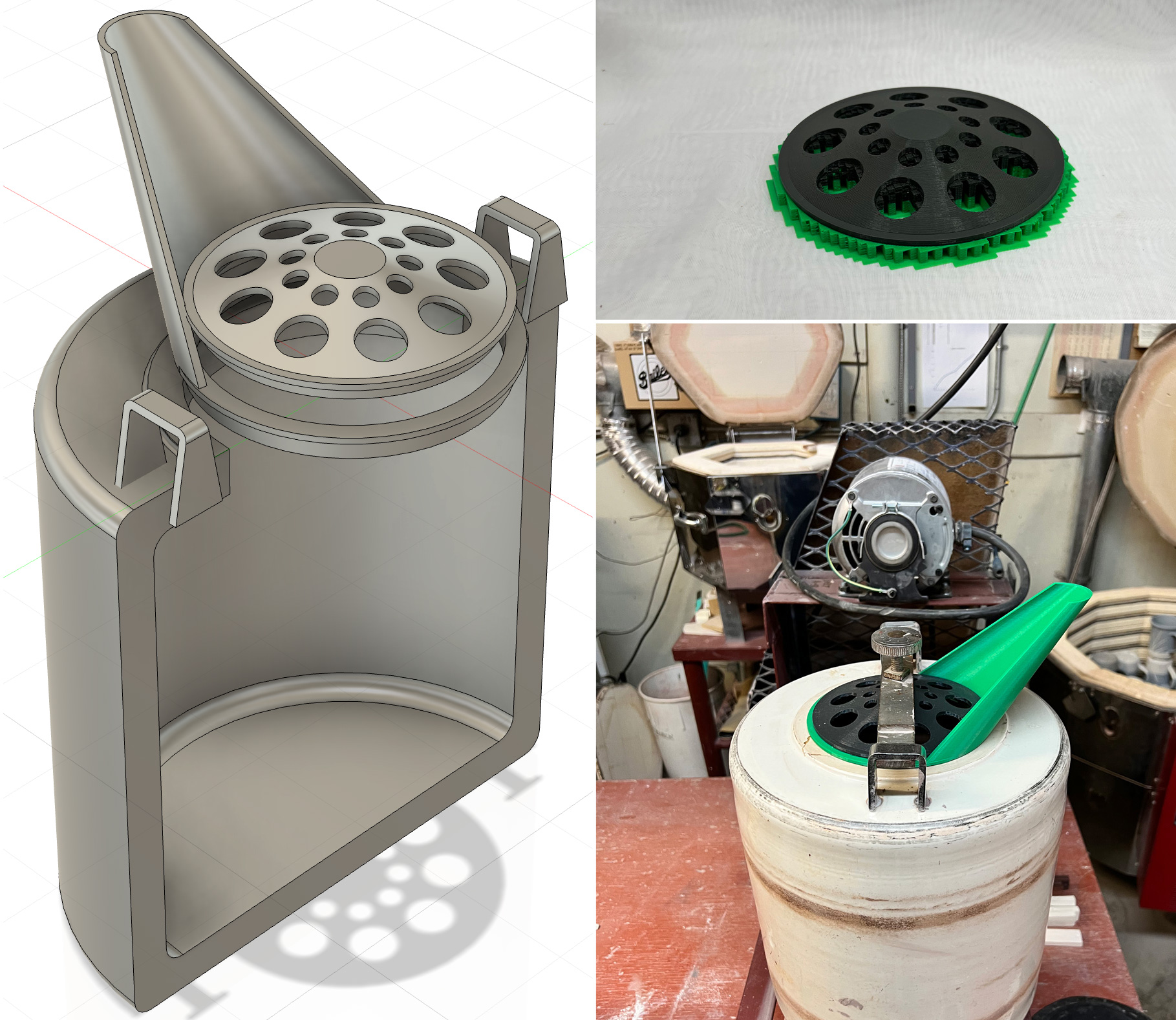| Monthly Tech-Tip | No tracking! No ads! | |
Ball milling
A method of grinding particles in ceramic powders and slurries. A porcelain, metal or rubber vessel filled with pebbles tumbles and particles are ground between colliding pebbles.
Key phrases linking here: ball milling, ball milled, ball-milled, ball mill - Learn more
Details
A device used to reduce the particle size of materials, bodies or glazes. A ball mill is simply a container that is filled with pebbles (either of porcelain or stones e.g. Flint) into which a charge (powder or slurry) is put and that is then mechanically rotated to cause the tumbling pebbles to crush particles that happen between them. Ball mills can be continuous or periodic, they can be small or gigantic, low-speed or high-speed rotated or vibrated or both. For maximum efficiency, a ball mill should be made of, or lined with, a porcelain or other very hard surface (so grinding also occurs between the wall and the balls), and the balls should be of a range of sizes (to maximize points of contact), the mill should have the correct quantity of balls, the slurry should be the right viscosity and the charge should be an optimal amount (overcharging reduces efficiency). Various compromises are often made (for example rubber lined mills to reduce wear and noise).
Large manufacturers hire ball mix supervisors, operators and mechanics. Commercial mills can be large enough to need 30 tons of balls! Technicians occupy themselves with getting a consistent and predictable processed product (surface area and particle size distribution), they employ mathematical formulas to determine the volume and weight of balls needed, the distribution of ball sizes and other operating parameters like duration and speed. They are wary of grinding products as mixes, it is often better to mill hard and soft powders separately and combine them later. Engineers typically use surface area measurement instrumentation to evaluate mill efficiency. Rheology of wet slurries being processed are also controlled, milling time and efficiency can be greatly improved by additives to increase cohesion.
Ball mills can reduce particles to nano sizes, the process is very important in creating powders used in hi-tech industries (e.g. alumina). Ball mills are slow compared to other methods of grinding, it could take hours, for example, to grind all the particles in a clay to minus 200 mesh. Industrial mills seeking nano-sizes might run 24 hours or more! Ball milling is normally done in conjunction with wet screening and/or roller-milling/air floating, for example, so that large particles have already been removed by the time the material reaches the ball mill. Air floating can also be done in consort with dust ball milling. The milling process can also reduce particle sizes by too much for an application, so a means of measuring the distribution of ultimate particles is important to be able to set the parameters for the process.
A clay body that has been ball milled will be more plastic, potentially much more plastic. Ball milling of the body or selected body materials will reduce or eliminate many types of fired glaze imperfections (especially specking, blistering and pin-holing). That being said, iron particulates are best removed before milling).
Milling a glaze will produce a cleaner-fired result with fewer imperfections. Materials deliver their chemistry to the glaze melt only if their particles dissolve in the melt. But some glaze materials are refractory and resistant to dissolving (e.g. silica, alumina). When silica does not completely dissolve in a transparent glaze, for example, it will fire cloudy and actual glaze thermal expansion will not be as low as it could be. However, by ball milling the silica to very small particle sizes all the particles will dissolve.
Milling of slurries presents fewer technical challenges than dust milling. We have found that thicker creamy slurries mill better than watery ones. A simple ball mill can be constructed by almost anyone, but obtaining the hard pebbles with the correct range of sizes for inside the mill can be a challenge (they are expensive).
In some places, the difficulty of finding specialists who still know how to reline ball mills used for the production of glazes, underglazes and engobes is motivating investment in alternative more modern grinding equipment.
Related Information
How long do you need to ball mill a glaze?

This picture has its own page with more detail, click here to see it.
You can measure to see. How? Wash a measured amount through a 200 mesh screen and note the amount of residue. These two show the oversize on a 200 mesh screen of 100 grams of glaze slurry. On the left: Unmilled. On the right: Milled 1 hour. Clearly, it needs more than 1 hour in this mill. A factor here is the high percentage of silica in this recipe. And the fact that the coarser grade of US Silica #95 was used (rather than #45).
Make your own ball mill rack - Front side

This picture has its own page with more detail, click here to see it.
DIY wheel mount ball mill rack

This picture has its own page with more detail, click here to see it.
Courtesy of Lawrence Weathers
Ball mill jar and rack made by @andygravesstructures

This picture has its own page with more detail, click here to see it.
3D printed spout for ball mill prevents hernias!
Available on the Downloads page

This picture has its own page with more detail, click here to see it.
When full of balls and glaze, this Royal Doulton ball mill weighs about 80 lbs. If efforts to pour it out don't cause a hernia, the slurry ends up spilling everywhere as the balls come out with it! Trying to stop the balls with my hand ends up spilling more. The answer was to 3D print two pieces: A spout and a ball retainer (upper right). The bar and screw that normally hold the lid on work well to keep the spout in place. For multiple batches of the same glaze, the jar can now be poured right from our table-mounted rack.
This was drawn in Fusion 360, but it would be doable in any other CAD program capable of revolving, extruding and lofting. I first printed the green ring and flange (without the spout) to achieve a good fit into the neck the jar. This took several prints. It became evident that a better seal is possible by scaling it back enough to make room for a wide rubber band stretched around it. Your jar will, of course, be different than this, so you'll have to custom-design for it. On cation: If printed using PLA filament, don't wash it in hot water or it could deform.
Possible to grind your own ceramic grade rutile?

This picture has its own page with more detail, click here to see it.
Yes, the granular and powdered grades of pure rutile are the same material. But, for producers, the milling process it is very difficult because the raw mineral is so hard. Commercial ceramic grade powder is minus 325 mesh, the companies doing this obviously have very good grinding equipment. They also have patience because even in this efficient porcelain ball mill, 90 minutes was only enough to get 50% to minus 325 mesh! The color of the powder is a good indication of its quality, the finer the grind the lighter tan it will be. That means you can use the color to gauge the mesh size. And, if you have a ball mill you can milled it more if needed.
Can we ball mill a clay and make it more colloidal? Yes.

This picture has its own page with more detail, click here to see it.
This 1000 ml 24 hour sedimentation test compares Plainsman A2 ball clay ground to 10 mesh (left) with that same material ball milled for an hour (right). The 10 mesh designation is a little misleading, those are agglomerates. When it is put into water many of those particles break down releasing the ultimates and it does suspend fairly well. But after 24 hours, not only has it settled completely from the upper section but there is a heavy sediment on the bottom. But with the milled material it has only settled slightly and there is no sediment on the bottom. Clearly, using an industrial attrition ball mill this material could be made completely colloidal.
Particle size drastically affects drying performance

This picture has its own page with more detail, click here to see it.
These DFAC testers compare the drying performance of Plainsman A2 ball clay at 10 mesh (left) and ball milled (right). This test dries a flat disk that has the center section covered to delay its progress in comparison to the outer section (thus setting up stresses). Finer particle sizes greatly increase shrinkage and this increases the number of cracks and the cracking pattern of this specimen. Notice it has also increased the amount of soluble salts that have concentrated between the two zones, more is dissolving because of the increased particle surface area.
An hour in a ball mill does less than I thought for this clay

This picture has its own page with more detail, click here to see it.
This is all of the oversize on a 35-200# PSD test of a clay body slurry of a 50-gram sample (thus the +200 mesh material). The oversize on the right was measured after 1 hour in our ball mill (porcelain jar). That hour only reduced the total +200 oversize from 7g to 3g. This underscores the amount of energy it can take to reduce the particle size of a ceramic material.
Links
| Articles |
Make Your Own Ball Mill Stand
Pictures of a ball mill rack that you can make yourself |
| Articles |
Ball Milling Glazes, Bodies, Engobes
Industries ball mill their glazes, engobes and even bodies as standard practice. Yet few potters even have a ball mill or know what one is. |
| URLs |
http://www.thecementgrindingoffice.com/typesofballmills.html
Types of Ball Mills |
| URLs |
https://www.tilemachinery.com
Xiangtan Weida Electrical and Machinery Co., Ltd They make feeders, crushers and grinders, Raymond mills, ball mills and filter presses, mixers, pug mills, cutting machines, forming presses, setting machines, kilns and dryers. Also production lines for cordierite catalysts, clay roofing, terra cotta facades, tile and ceramic rollers. |
| URLs |
https://www.sbm-mill.com
SBM Shibang Machinery They manufacture Raymond mills, crushers, vertical roller mills, trapezium mills, ball mills, hammer mills, and vibrating screens for the mineral processing. |
| URLs |
https://alpapowder.com
Biggest ultrafine powderizing equipment manufacturer in China 2024 Air Jet Mill, Air Classifying Mill, Classifier, Ball Mill and Classifying, powder surface modification. |
| URLs |
https://morehousecowles.com/products/mills/stone-mills/
MorehouseCowles Stone Grinding equipment for continuous particle reduction |
| URLs |
https://colloid-mills.com/colloid-mill-type-o
Colloid Mills - Since 1926 building colloid mills, multi-stage grinding gear and perforated disk mills. |
| By Tony Hansen Follow me on        |  |
Got a Question?
Buy me a coffee and we can talk

https://digitalfire.com, All Rights Reserved
Privacy Policy
